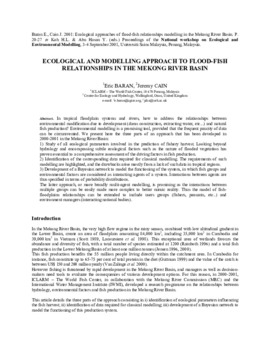Ecological and modelling approach to flood-fish relationships in the Mekong River Basin
Abstract
In tropical floodplain systems and rivers, how to address the relationships between environmental modification due to development (dams construction, extracting water, etc...) and natural fish production? Environmental modelling is a promising tool, provided that the frequent paucity of data can be circumvented. We present here the three parts of an approach that has been developed in 2000-2001 in the Mekong River Basin: 1) Study of all ecological parameters involved in the prediction of fishery harvest. Looking beyond hydrology and encompassing subtle ecological factors such as the nature of flooded vegetation has proven essential to a comprehensive assessment of the driving factors in fish production. 2) Identification of the corresponding data required for classical modelling. The requirements of such modelling are highlighted, and the drawbacks arise mostly from a lack of such data in tropical regions. 3) Development of a Bayesian network to model the functioning of the system, in which fish groups and environmental factors are considered as interacting agents of a system. Interactions between agents are thus specified in terms of probability distributions. The latter approach, or more broadly multi-agent modelling, is promising as the interactions between multiple groups can be easily made more complex to better mimic reality. Thus the model of fish-floodplains relationships can be extended to include users groups (fishers, peasants, etc..) and environment managers (interacting national bodies)

